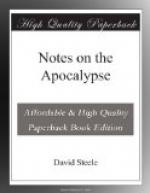In the mean time, what do these “four animals” represent? Not the adorable Trinity, as some learned men have imagined; nor holy angels, as more learned men have supposed and laboured to prove. These “animals” are worshippers; (v. 8,) therefore they are not the Object of worship. They are culpably blind who mistake the creature for the Creator. (Rom. i. 25.) Other expositors have attempted, with greater plausibility, but no better success, to prove these animals to be symbolical of angels. For this purpose, reference has been made to Isaiah’s vision of the seraphims, (ch. vi. 2,) and also to the “four living creatures” which appeared in vision to Ezekiel, (i. 5-10.) The identity of John’s “animals” and Ezekiel’s “living creatures” is argued especially from their number, “four,” and their “faces” being the same. To the thoughtful and unbiased reader it is sufficient to reply,—that John’s “animals” acknowledge themselves to have been redeemed by the blood of the Lamb, (ch. v. 8, 9,) an expression which is inapplicable to angels. As the “four and twenty elders” and the “four animals” comprise the whole company of the redeemed, as distinguished from the higher and lower orders of God’s worshippers, (ch. v. 8-14,) and as the “elders” represent the whole church, it would seem to be reasonable to suppose, that these “animals” are the symbols of the gospel ministry. And to this agree their functions as exercised in the farther developments of this book, as we shall see.
One plausible objection to this interpretation is grounded on the fact that their “faces” are the same as those of Ezekiel’s angels,—“of an ox, or young calf, of a lion, of a man, and of an eagle.” But each of the “cherubims” had “four faces” whereas these “animals” have but one face each. Nor ought it to be thought incongruous that faithful ministers are represented as possessing some of the properties of holy angels, when we find them called by the same name: (ch. i. 20;) and also, when we find the Master directing them to imitate and emulate holy angels in their services. (Matt. vi. 10; Ps. ciii. 20, 21.) These “animals,” emblematical of the gospel ministry, are in number “four,” answerable to the universality of their mission into the four quarters of the earth,—“all the world.” (Matt, xxviii. 19; Mark, xvi. 15.) So the “four winds,” (ch. vii. 1,) mean all winds. As the “lion, which is the strongest among beasts, and turneth not away for any,” is distinguished for courage and magnanimity; so, as a symbol, it represents a ministry of courageous and heroic spirit. Luther in continental, and Knox in insular Europe, may be named as displaying this prominent feature of ministerial character. The “calf” or young ox, symbolizes “patient continuance in well-doing” amidst trials, such as “cruel mockings,” etc. The “face as a man” indicates sagacity, “Christian prudence,” together with active sympathy. The “flying eagle” is emblematical of




